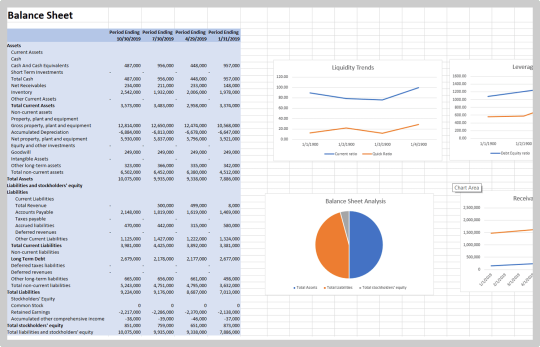#Automate Repetitive Tasks with Macros
Text
Elevate Client Services with Excel: Expert Tips for Financial Consultants by Grayson Garelick

Financial consultants operate in a dynamic environment where precision, efficiency, and client satisfaction are paramount. Excel, as a versatile tool, offers an array of features that can significantly enhance the services provided by financial consultants. Grayson Garelick, an accomplished financial analyst and consultant, shares invaluable Excel tips to help financial consultants elevate their client services and add tangible value.
The Role of Excel in Financial Consulting
Excel serves as the backbone of financial consulting, enabling consultants to analyze data, create models, and generate insights that drive informed decision-making. As the demands of clients become increasingly complex, mastering Excel becomes essential for financial consultants aiming to deliver exceptional services.
1. Customize Excel Templates
One of the most effective ways to streamline workflows and improve efficiency is by creating customized Excel templates tailored to specific client needs. Grayson suggests developing templates for budgeting, forecasting, and financial reporting that can be easily adapted for different clients, saving time and ensuring consistency.
2. Utilize PivotTables for Data Analysis
PivotTables are powerful tools in Excel that allow financial consultants to analyze large datasets and extract meaningful insights quickly. Grayson emphasizes the importance of mastering PivotTables for segmenting data, identifying trends, and presenting information in a clear and concise manner to clients.
3. Implement Conditional Formatting
Conditional formatting is a valuable feature in Excel that allows consultants to highlight important information and identify outliers effortlessly. By setting up conditional formatting rules, consultants can draw attention to key metrics, discrepancies, or trends, facilitating easier interpretation of data by clients.
4. Leverage Excel Add-ins
Excel offers a variety of add-ins that extend its functionality and provide additional features tailored to financial analysis and reporting. Grayson recommends exploring add-ins such as Power Query, Power Pivot, and Solver to enhance data manipulation, modeling, and optimization capabilities.
5. Automate Repetitive Tasks with Macros
Macros enable financial consultants to automate repetitive tasks and streamline workflows, saving valuable time and reducing the risk of errors. Grayson advises recording and editing macros to automate tasks such as data entry, formatting, and report generation, allowing consultants to focus on value-added activities.
6. Master Advanced Formulas and Functions
Excel's extensive library of formulas and functions offers endless possibilities for financial analysis and modeling. Grayson suggests mastering advanced formulas such as VLOOKUP, INDEX-MATCH, and array formulas to perform complex calculations, manipulate data, and create sophisticated models tailored to client needs.
7. Visualize Data with Charts and Graphs
Visualizing data is essential for conveying complex information in an easily digestible format. Excel offers a variety of chart types and customization options that enable consultants to create compelling visuals that resonate with clients. Grayson recommends experimenting with different chart styles to find the most effective way to present data and insights.
8. Collaborate and Share Workbooks Online
Excel's collaboration features enable financial consultants to work seamlessly with clients, colleagues, and stakeholders in real-time. Grayson highlights the benefits of sharing workbooks via OneDrive or SharePoint, allowing multiple users to collaborate on the same document, track changes, and maintain version control.
9. Protect Sensitive Data with Security Features
Data security is a top priority for financial consultants handling sensitive client information. Excel's built-in security features, such as password protection and encryption, help safeguard confidential data and ensure compliance with regulatory requirements. Grayson advises implementing security protocols to protect client data and maintain trust.
10. Stay Updated with Excel Training and Certification
Excel is a constantly evolving tool, with new features and updates released regularly. Grayson stresses the importance of staying updated with the latest Excel training and certification programs to enhance skills, explore new capabilities, and maintain proficiency in Excel's ever-changing landscape.
Elevating Client Services with Excel Mastery
Excel serves as a catalyst for innovation and excellence in financial consulting, empowering consultants to deliver exceptional services that add tangible value to clients. By implementing Grayson Garelick Excel tips, financial consultants can streamline workflows, enhance data analysis capabilities, and foster collaboration, ultimately driving client satisfaction and success. As financial consulting continues to evolve, mastering Excel remains a cornerstone of excellence, enabling consultants to thrive in a competitive landscape and exceed client expectations.
#Financial Consulting#grayson garelick#Customize Excel Templates#Utilize PivotTables#Implement Conditional Formatting#Leverage Excel Add-ins#Automate Repetitive Tasks with Macros#Advanced Formulas and Functions#Visualize Data with Charts and Graphs#Collaborate and Share Workbooks#Protect Sensitive Data with Security#Stay Updated with Excel Training#Elevating Client Services with Excel
2 notes
·
View notes
Text
Clinical SAS programming A complete guide
Introduction
Clinical SAS programming is a specialized field that utilizes the SAS programming language to handle the vast and complex data generated in clinical trials. SAS, a statistical software package, is extensively employed by pharmaceutical and biotechnology companies for its robust data management, analysis, and reporting capabilities.
In terms of data management, SAS is used to clean, transform, and manage large datasets, ensuring they are organized and ready for analysis. This is a critical step in clinical trials, where large volumes of data are collected and need to be processed efficiently.

For analysis, SAS can perform a wide range of statistical analyses, including descriptive statistics, inferential statistics, regression analysis, survival analysis, and analysis of variance (ANOVA). These analyses are crucial in interpreting the data collected in clinical trials and drawing meaningful conclusions.
Finally, Clinical SAS programming is also used for reporting. It can generate various reports, including integrated summaries of safety and efficacy (ISS/ISE), clinical study reports (CSRs), and other regulatory documents. These reports are essential for communicating the results of clinical trials to regulatory authorities, medical professionals, and the public.
SAS in Clinical Domain
Data Management: SAS is used to clean, transform, and manage clinical trial data. It can handle large datasets and perform data validation, data integration from different sources.
Statistical Analysis: SAS is used for statistical analyses, such as descriptive statistics, inferential statistics, regression analysis, survival analysis, and analysis of variance (ANOVA). These analyses help researchers and clinicians to draw conclusions from clinical trial data.
Data Validation: Checking the accuracy, consistency, and completeness of clinical trial data by performing data validation checks, identifying discrepancies, and resolving data-related issues.

Safety Reporting: Generating safety reports and listings to monitor adverse events and safety data during the trial.
SDTM (Standard Data Tabulation Model) Conversion: Converting clinical trial data into SDTM format, which is a standardized data model for regulatory submission.
ADaM (Analysis Data Model) Implementation: Creating ADaM datasets, which are analysis-ready datasets used for statistical analysis.
Report Generation: Preparing clinical trial reports, including integrated summaries of safety and efficacy (ISS/ISE), clinical study reports (CSRs), and other regulatory documents.
Data Quality Control: Implementing quality control procedures to ensure the accuracy and reliability of analysis results.
Data Visualization: Creating data visualizations, such as graphs and plots, useful for data exploration and presentation of result.
Automation: Creating SAS macros to streamline and automate repetitive tasks and improve programming efficiency.
Medical Coding: Performing medical coding of adverse events, concomitant medications, and medical history terms using standardized dictionaries like MedDRA (Medical Dictionary for Regulatory Activities) and WHO Drug.
Career in Clinical SAS
A career in Clinical SAS programming is rewarding and offers a wide range of opportunities. The SAS Academy for Clinical Programming offers a comprehensive training program that prepares you to work as a SAS Certified Clinical Trials Programming Professional. The combination of coursework and hands-on learning helps you build a foundation of clinical research theory and data analysis skills.
Conclusion
Clinical SAS programming is indeed a vital skill in the pharmaceutical and biotechnology industries. With a solid foundation in SAS programming and a comprehensive understanding of clinical trials, you can pave the way for a successful career in this field.
Whether you’re a biostatistician, a clinical SAS programmer, or someone interested in the field, learning Clinical SAS programming can open doors to a plethora of opportunities. It’s not just about job prospects; it’s about contributing to the advancement of medical research and the development of new treatments and therapies.
In conclusion, mastering Clinical SAS programming is not only professionally rewarding but also offers the chance to make a significant impact in the healthcare industry.
what are the best ways to learn Clinical SAS?
We run a training institute in Hyderabad named Brolly Academy. We do offer best Clinical SAS training in Hyderabad with job assistance. Now when you list the best ways to learn Clinical SAS include Brolly academy's Clinical SAS Training as one of the way.

2 notes
·
View notes
Text
Automating Tasks in AutoCAD: Time-Saving Workflows

Introduction
In today's fast-paced digital world, efficiency is key. As professionals in the field of digital design and engineering, we often find ourselves grappling with the challenge of maximizing productivity while maintaining precision. AutoCAD, a staple in the realm of computer-aided design (CAD), offers a myriad of tools and features to aid in this endeavor. However, one aspect that stands out in revolutionizing workflows is the integration of AutoCAD automation techniques.
Streamlining AutoCAD Tasks with Automation
AutoCAD automation techniques are the cornerstone of efficient design workflows. By harnessing the power of automation, designers and engineers can significantly reduce the time spent on repetitive tasks, allowing for a more streamlined and productive workflow.
One of the primary benefits of AutoCAD automation is the ability to create custom scripts and macros. These scripts can automate tasks such as repetitive drawing tasks, batch processing of files, and generating reports, among others. By investing time in setting up these automation scripts initially, users can save countless hours in the long run.
Time-Saving Workflows
Let's delve into some specific examples of how automation can streamline tasks in AutoCAD:
Batch Processing: Imagine having to convert multiple DWG files to PDF format manually. With automation scripts, you can create a batch process that handles this task swiftly and accurately, freeing up your time for more critical design work.
Standardization: Automation allows you to enforce standardization across your designs effortlessly. For instance, you can create templates that automatically apply standardized layers, text styles, and dimension styles to new drawings, ensuring consistency throughout your projects.
Data Extraction: Extracting data from CAD drawings can be a time-consuming process. Automation scripts can be developed to extract specific data points from drawings and generate reports automatically, saving you the hassle of manual data entry.
Custom Commands: Automation enables you to create custom commands tailored to your workflow. For example, you can create a command that automatically inserts commonly used blocks or symbols with predefined attributes, enhancing efficiency and accuracy.
Implementing Automation Techniques
To start harnessing the power of AutoCAD automation, follow these steps:
Identify Repetitive Tasks: Take note of tasks that you find yourself performing repeatedly. These are prime candidates for automation.
Learn AutoCAD Scripting: Familiarize yourself with AutoCAD scripting languages such as AutoLISP, Visual Basic for Applications (VBA), and AutoCAD Core Console (ACC). These languages allow you to create custom scripts and macros.
Develop Automation Scripts: Once you're comfortable with scripting, start developing automation scripts to automate your identified tasks. Don't hesitate to seek online resources or consult with experts to refine your scripting skills.
Test and Refine: Test your automation scripts thoroughly to ensure they perform as intended. Refine and optimize your scripts based on feedback and experience to maximize their effectiveness.
Conclusion
In conclusion, AutoCAD automation techniques offer a powerful means to Streamlining AutoCAD tasks workflows and save valuable time in the digital design process. By leveraging automation, you can enhance productivity, enforce standardization, and focus on creative aspects of your designs. Invest time in learning and implementing automation techniques, and you'll reap the rewards of a more efficient and effective design workflow.
Remember, the key to successful automation is understanding your workflow and tailoring automation solutions to fit your specific needs. With AutoCAD's robust automation capabilities and your creativity, the possibilities for time-saving workflows are endless.
If you're ready to take your AutoCAD skills to the next level and explore the world of automation, dive in and discover the transformative power of streamlining AutoCAD tasks.
Suggested Blogs: -
Advanced AutoCAD techniques
Interior design decor ideas
Efficient CAD techniques
#attitudeacademyblogs#attitudeacademy#AutoCADblog#LearnNow#LearnMore#Blogs#BestBlogforAutoCAD#Skills
0 notes
Text
A Glance At Excel Training Online
At the core of Excel excel's proficiency is the ability to work faster and more effectively. For beginners, understanding the many features and functions associated with Microsoft Excel can significantly enhance productivity and effectiveness in the workplace. When you're organizing data or creating charts or analyzing information, Excel is a powerful tool that will streamline your work and increase the efficiency of your workflow. Excel training courses offered online and in person, offer an organized method of learning the ins and outs of this flexible software. For those who are just beginning, beginner courses provide an excellent foundation, covering essential features such as creating formulas, formatting cells and managing worksheets. The courses usually include activities that require hands-on experience and real examples to help students reinforce their learning and build confidence. As Excel users advance to advanced levels, Excel training is essential for making the most of Excel software. Advanced courses delve into complex operations, data analysis techniques, and automated tools that reduce time and effort.

The ability to utilize the pivot table, macros and VBA (Visual Basic for Applications) provides a wealth of possibilities for customizing Excel to meet specific requirements and requirements. One of the advantages of Excel online training is the flexibility they provide. Participants can learn at their own pace, and access the materials and training whenever it's appropriate for them. This flexibility is especially beneficial for professionals who are busy juggling their work schedule and other obligations. Online courses typically provide lifetime access to course materials, allowing learners to revisit their concepts and improve their knowledge whenever they want to. Moreover, Excel training courses cater to different learning styles and styles. Certain courses concentrate on video tutorials and provide detailed instructions that are accompanied by visual demonstrations. Some courses provide interactive modules as well as quizzes to test understanding and retention. Regardless of the method used, the objective is to empower users to improve their proficiency in Excel and use its features to their advantage. If you're looking to boost their resume or enhance their job prospects, completing the Microsoft Excel course can be an excellent investment.
Many employers require or prefer candidates with Excel proficiency, particularly when it comes to roles that require data analysis financial modeling, data analysis, or project management. If they can demonstrate proficiency in Excel candidates will stand out in a competitive job market and increase their chances of getting the job they've always wanted. Furthermore knowing how to use Excel is not just about completing tasks--it's about doing them more efficiently. Time saving features such as keys, autofill, and conditional formatting are able to significantly reduce time that is spent working on repetitive tasks, allowing users to focus on more important aspects of their work. Excel's capacity to manage large files and carry out complex calculations makes it a necessity in industries ranging from accounting and finance as well as marketing as well as human resource. Excel training courses equip beginners with the skills and knowledge that they require to succeed in their work. Whether pursuing a career in business, finance or another field having a solid understanding of Excel can be a significant resource that opens doors to opportunities. Through investing in Excel instruction, students are able to accelerate their learning curve and grow into more efficient, productive, and productive professionals.
0 notes
Text
Exploring FreeCAD Macros and Python Scripting


FreeCAD macros are powerful tools that allow users to automate repetitive tasks and enhance their workflow. By writing simple scripts in Python, users can create customized macros to perform specific actions within the FreeCAD environment. This flexibility empowers users to streamline processes, increase efficiency, and unlock new possibilities in their design projects.
Harnessing the Power of Python Scripting
Python scripting in FreeCAD opens up a world of endless possibilities for customization and automation. By leveraging the rich functionality of Python, users can create complex scripts to tackle intricate design challenges with ease. From parametric modeling to advanced simulations, Python scripting in FreeCAD offers a robust platform for innovation and experimentation.
Unlocking Efficiency and Productivity
By combining FreeCAD macros and Python scripting, users can achieve unparalleled levels of efficiency and productivity in their design work. With the ability to automate repetitive tasks, generate complex geometries, and interact with external data sources, FreeCAD becomes a dynamic tool that adapts to the unique needs of each user. This fusion of creativity and functionality empowers users to push the boundaries of what is possible in the world of 3D design.
Embracing Innovation and Exploration
Exploring FreeCAD macros and Python scripting is not just about mastering tools and techniques; it is a journey of discovery and innovation. By experimenting with different scripts, pushing the limits of creativity, and embracing a spirit of curiosity, users can unlock new pathways to inspiration and insight. The combination of technical proficiency and creative exploration fuels a cycle of continuous improvement and growth in the realm of FreeCAD design.
Elevating Your Design Experience
Incorporating FreeCAD macros and Python scripting into your design workflow is more than just a practical choice; it is a transformative experience that elevates your creative potential. By embracing the power of automation, customization, and innovation, you can revolutionize the way you approach design challenges and unleash your full creative capacity. Take the leap into the realm of FreeCAD macros and Python scripting, and let your imagination soar to new heights.
In conclusion, the fusion of FreeCAD macros and Python scripting offers a gateway to a realm of endless possibilities in the world of 3D design. By harnessing the power of automation, customization, and innovation, users can unlock new pathways to creativity, efficiency, and productivity. Take the first step on this exciting journey of exploration and discovery, and see where your imagination takes you in the dynamic universe of FreeCAD design.
Read the full article
0 notes
Text
Excel Elite: Advanced Functions, Data Analysis & Automation
Excel Elite is a comprehensive course designed to elevate your Excel skills. Learn advanced functions like INDEX/MATCH, VLOOKUP, and SUMIF(S)/COUNTIF(S) to manipulate data with precision. Master PivotTables, PivotCharts, and Power Query for in-depth data analysis and visualization. Automate repetitive tasks with macros and VBA to streamline your workflow. Whether you're a business analyst, data scientist, or finance professional, Excel Elite will empower you to excel in your role.

0 notes
Text
Unlock Your Potential with Online Excel Courses in Southern Africa
In today's fast-paced business environment, proficiency in Microsoft Excel is more than just an asset—it's a necessity. Whether you're analyzing data, managing budgets, or tracking projects, Excel's powerful features can significantly enhance your efficiency and effectiveness.
For professionals and students across Southern Africa, online Excel courses have become a gateway to mastering this indispensable tool. Let's dive into how these courses can transform your data management skills and why an advanced Excel course could be the next step in your career development.
Excel Essentials: A Foundation for Success
Starting with the basics, Excel courses online in Southern Africa offer a comprehensive curriculum designed to introduce learners to the world of spreadsheets. These courses cover everything from simple data entry and formatting to more complex functions and formulas. For beginners, understanding the core principles of Excel is crucial. It not only streamlines daily tasks but also sets the foundation for more advanced data analysis and visualization techniques.

Excel Courses Online Southern Africa is tailored to meet the needs of a diverse audience, from students just starting their careers to seasoned professionals looking to update their skills. These courses are structured to provide flexibility, allowing learners to progress at their own pace. With the rise of e-learning platforms, accessing these resources has always been challenging, enabling individuals across Southern Africa to enhance their Excel skills from the comfort of their homes or offices.
Advancing Your Skills: The Next Step
For those looking to delve deeper, an Advanced Excel Course Online Southern Africa offers the perfect opportunity to expand your expertise. These advanced courses are designed to explore the more sophisticated aspects of Excel, including macro creation, advanced data analysis, pivot tables, and the use of Power Query and Power Pivot. Such skills are invaluable in a world where data drives decisions, empowering you to not only manage but also interpret and present data in meaningful ways.
An advanced course is particularly beneficial for those in roles that demand extensive data manipulation and analysis, such as finance, marketing, and project management. It equips professionals with the tools to handle complex datasets, automate repetitive tasks, and create dynamic reports and dashboards that inform strategic decision-making.
Connecting with the Best Resources
Finding the right platform for your Excel training is critical. For learners in Southern Africa, seeking out courses that offer both foundational and advanced modules with practical, real-world applications is essential. These courses should be led by experienced instructors who can provide personalized feedback and support.
Conclusion
In the digital age, Excel remains an unparalleled tool for data management and analysis. Whether you're just beginning your journey or looking to elevate your skills, online Excel courses offer a path to mastery. For those in Southern Africa, engaging with Excel Courses Online Southern Africa and Advanced Excel Course Online Southern Africa provides the knowledge and confidence to harness the full potential of Excel.
For a comprehensive learning experience that covers both beginner and advanced levels, consider exploring the offerings at collegeafricagroup.com. With a wide range of courses tailored to meet the evolving needs of today's professionals, College Africa Group stands out as a leading provider of online Excel training in Southern Africa. Empower yourself with the skills to excel in your career by signing up for a course today.
0 notes
Text
From Raw Data to Actionable Insights: Excel Reporting Tools Demystified

In the realm of data analysis and business intelligence, the ability to transform raw data into actionable insights is paramount for informed decision-making. Excel, a ubiquitous tool in the business world, offers a powerful platform for this purpose. Excel reporting tools provide users with the means to efficiently organize, analyze, and visualize data, ultimately enabling stakeholders to gain valuable insights that drive business growth and success.
At its core, Excel serves as a versatile spreadsheet application, allowing users to input, manipulate, and analyze data in various formats. However, its reporting capabilities extend far beyond simple data entry and calculation. With the right approach and techniques, Excel can be transformed into a sophisticated reporting tool that facilitates the conversion of raw data into actionable insights.
The journey from raw data to actionable insights begins with data collection and organization. Excel provides users with intuitive features for importing data from various sources, such as databases, CSV files, and web queries. Once imported, the data can be organized into structured tables, making it easier to manage and analyze. Excel's sorting and filtering capabilities further enhance data organization, enabling users to quickly identify trends, outliers, and patterns within their datasets.
Once the data is organized, the next step is analysis. Excel offers a plethora of functions and formulas for performing calculations, statistical analysis, and data manipulation. Whether it's calculating averages, performing regression analysis, or generating descriptive statistics, Excel provides users with the tools they need to uncover valuable insights hidden within their data. Additionally, Excel's built-in charting features allow users to create visually appealing charts and graphs that facilitate data interpretation and communication.
However, the true power of Excel reporting tools lies in their ability to create dynamic and interactive reports. Excel's pivot tables and pivot charts enable users to summarize and analyze large datasets with ease, providing a flexible framework for data exploration and visualization. By simply dragging and dropping fields, users can generate insightful summaries, identify trends, and drill down into specific subsets of data. Moreover, Excel's slicers and timelines allow users to filter and interact with their data dynamically, empowering stakeholders to explore different scenarios and gain deeper insights into their business operations.
Furthermore, Excel reporting tools can be customized and automated to suit the unique needs of each organization. Excel's powerful scripting language, Visual Basic for Applications (VBA), enables users to create macros and automate repetitive tasks, such as data importation, formatting, and report generation. By leveraging VBA, users can streamline their reporting processes, reduce errors, and save valuable time and resources.
In addition to its robust analytical capabilities, Excel also excels in data visualization. Excel's charting features offer a wide range of chart types, styles, and customization options, allowing users to create visually stunning reports that effectively communicate their findings. Whether it's a simple bar chart, a complex scatter plot, or an interactive dashboard, Excel provides users with the tools they need to convey their insights in a clear and compelling manner.
In conclusion, Excel reporting tools provide users with a powerful platform for transforming raw data into actionable insights. From data collection and organization to analysis, visualization, and automation, Excel offers a comprehensive suite of features and functionalities that enable users to unlock the full potential of their data. By harnessing the power of Excel, organizations can gain valuable insights that drive informed decision-making, optimize business processes, and ultimately achieve their strategic objectives.
0 notes
Text

Streamline Your Workflow: Automating Revit Processes
Discover the power of automation in Revit with our comprehensive guide. Whether you're an architect, engineer, or designer, optimizing your workflow is essential for efficiency and productivity. In this guide, we'll explore various techniques and tools to automate repetitive tasks, streamline project management, and enhance collaboration. From creating custom scripts and macros to leveraging Revit API integrations, you'll learn how to maximize the potential of this powerful BIM software. Say goodbye to manual processes and hello to a more streamlined, productive workflow with automate Revit solutions.
#Automate Revit#Revit Automation Tools#Revit Automation Tool#Automate Bim Task#Revit Automation#Automate Revit Tasks#Automation Bim#Revit Automation Plugin#Revit To Excel#Revit Excel Link
0 notes
Text
Spreadsheet Conversion: Automating Data Management
Spreadsheets are an essential tool for individuals, companies, and organizations in today's data-driven world. Spreadsheets help manage finances, keep track of project progress, and assess sales statistics because they provide an adaptable method of organizing and editing data.. Spreadsheets must be converted into many forms to meet diverse purposes, though, as data must expand and change. This article explores the process of converting spreadsheets, the tools available, and common questions surrounding this task.
Understanding Spreadsheet Conversion
Converting spreadsheets entails transferring data across formats while maintaining its structure and integrity. Connectivity depends on this process, which makes it possible for data to be shared and used across many platforms and applications. Common conversion tasks include:
Spreadsheets can be converted between CSV (Comma-Separated Values), Microsoft Excel (.xlsx), and Sheets from Google formats.
Data extraction is a technique used to extract particular information from spreadsheets for presentation or research purposes.
Data integration is a method of collecting information from several spreadsheets or databases into a single dataset.
For optimal reliability as well as precision, data cleansing purges spreadsheets of duplicates, formatting errors, and oddities.
Tools for Spreadsheet Conversion
Several tools and software solutions facilitate spreadsheet conversion, catering to diverse user needs and preferences. Some popular options include:
Microsoft Excel: Spreadsheets can be converted to CSV, PDF, and XML, among other formats, using Excel's built-in utilities.
Google Sheets: Offering cloud-based collaboration and straightforward file sharing, Google Sheets has translation capabilities similar to those of Excel.
OpenOffice Calc: This free spreadsheet converter that supports a wide range of file formats is a useful substitute for Excel.
Online converters: You'll find an array of free or subscription-based online tools and converters offering easy and quick spreadsheet conversion without requiring installation programs.
Conclusion
One essential component of data management is spreadsheet conversion, which gives users the flexibility to modify and use data in a variety of ways. The capacity to convert spreadsheets effectively is critical for improving productivity and decision-making, whether it is for converting file formats, extracting particular information, or integrating data from several sources. Users may quickly execute spreadsheet conversion activities to match their requirements and improve their data workflows with the wide array of tools and software solutions available.
FAQs
Can I convert complex spreadsheets with formulas and macros intact?
Almost all spreadsheet conversion solutions maintain your data's validity by preserving macros and formulas throughout the conversion process.
Does the amount of space or number of spreadsheets that can be converted have any restrictions?
Large, complicated spreadsheets can be handled successfully by many current answers, while certain programs may have restrictions on file size or complication.
Is spreadsheet conversion secure?
When using reputable software and tools, spreadsheet conversion is generally secure. However, it's essential to exercise caution when sharing sensitive data and to use secure connections when working with online converters.
Is it possible to computerize the conversion of spreadsheets?
Indeed, many products have automation features that let users plan and set up time- and effort-saving automation for repetitive conversion operations.
Spreadsheet conversion, in its simplest form, is an essential step in efficiently managing and using data, enabling users to modify and streamline their data operations in response to changing demands and obstacles. Users can realize the entire potential of their data assets by converting spreadsheets into a smooth and effective endeavour with the correct tools and techniques.
1 note
·
View note
Text
The Role and Impact of Macros in Gaming
In the realm of gaming, macros have become a prevalent tool, often used to enhance performance and streamline gameplay. Among the various types of macros, the no recoil macro stands out, particularly in first-person shooter (FPS) games. Additionally, macro scripts and Logitech macros have gained popularity, offering players a competitive edge through automated actions.
Macro script are sequences of pre-defined inputs programmed to execute specific commands or actions in a game. These scripts can be created manually or obtained from online sources, allowing players to automate complex maneuvers or repetitive tasks with ease. Logitech macros, specifically tailored for Logitech gaming peripherals, offer users a convenient way to assign macros to their mouse buttons or keyboard keys through dedicated software.
One of the most sought-after macros in FPS games is the no recoil macro. This macro is designed to counteract the recoil generated by firearms in-game, resulting in more accurate and controlled shots. By eliminating the need for manual recoil compensation, players can maintain steady aim and increase their chances of hitting targets with precision.
Despite the controversy surrounding macros, their widespread use underscores their significance in modern gaming. For many players, macros serve as valuable tools for customization, efficiency, and optimization of gaming experiences. Whether used for simplifying complex tasks or fine-tuning gameplay mechanics, macros continue to shape the landscape of gaming in profound ways.
Macros, including no recoil macros, macro scripts, and Logitech macro, play a significant role in gaming, offering players a range of benefits and customization options. While their use may spark debates regarding fairness and skill, their prevalence highlights their importance in enhancing gameplay experiences for many enthusiasts.
1 note
·
View note
Text
The Use of No Recoil Macros and Logitech Macros in Gaming
Macro script have become a popular tool in the gaming community, offering players various advantages and enhancements to their gameplay experience. Among these, no recoil macro and Logitech macro have gained significant attention for their ability to mitigate recoil in shooting games and automate repetitive tasks.
No recoil macro are scripts designed to eliminate or significantly reduce the recoil of firearms in first-person shooter (FPS) games. Recoil, the upward movement of a weapon after firing, can affect a player's accuracy and control during gameplay. No recoil macro work by automatically countering this recoil, allowing players to maintain steady aim and fire more accurately over sustained periods.
These macro are often customizable, allowing players to adjust settings according to their preferences and the specific characteristics of different weapons within a game. By reducing recoil, players gain a competitive edge, especially in online multiplayer matches where precision and speed are crucial for success.
Logitech macro, specifically designed for Logitech gaming peripherals such as mice and keyboards, offer a wide range of functionalities beyond recoil control. These macro allow players to automate complex sequences of actions, assign multiple commands to a single keystroke or mouse button, and streamline repetitive tasks within games.
With Logitech macro, players can create custom shortcuts for in-game actions, optimize their gameplay efficiency, and enhance their overall gaming experience. Whether it's executing intricate combos in fighting games, performing precise building techniques in sandbox games, or executing quick inventory management in survival games, Logitech macro provide players with greater control and flexibility.
The use of no recoil macro and Logitech macro has sparked debates within the gaming community regarding fairness, skill, and the integrity of competitive play. Some argue that these macro provide an unfair advantage, allowing players to bypass the skill required to manage recoil manually or execute complex actions in-game. Others view macro as legitimate tools that enhance accessibility and allow players to tailor their gaming experience to their preferences and abilities.
Despite the controversy, the popularity of these macro persists, with many players incorporating them into their gaming setups to improve performance and efficiency. As technology continues to evolve, so too will the capabilities of macro, raising questions about their role in shaping the future of gaming and the boundaries between skill and automation.
1 note
·
View note
Text
Advanced Excel Tips and Tricks for Efficient Data Analysis

Introduction
In today's data-driven world, Excel remains a powerhouse tool for organizing and analyzing information. Whether you're a seasoned data analyst or just starting, mastering advanced Excel techniques can significantly boost your efficiency and effectiveness. In this blog post, we'll delve into some invaluable tips and tricks that will enhance your Efficient Excel data analysis skills and help you derive actionable insights from your data.
Utilize PivotTables for Dynamic Analysis PivotTables are a game-changer when it comes to summarizing and analyzing large data sets. They allow you to rearrange and summarize data quickly, making it easier to identify trends and patterns. To make the most of PivotTables, ensure your data is well-structured with clear headers and consistent formatting.
Master Advanced Functions Excel offers a plethora of powerful functions that can streamline your data analysis tasks. Functions like VLOOKUP, INDEX-MATCH, SUMIF(S), and IFERROR are invaluable for performing complex calculations and data manipulations. Familiarizing yourself with these functions can save you considerable time and effort.
Apply Conditional Formatting Conditional formatting is a handy feature that allows you to visually highlight important data points based on specific criteria. Whether you want to spot outliers, identify trends, or flag errors, conditional formatting can make your data analysis more intuitive and insightful.
Harness the Power of Macros Macros are automation tools that can record your actions in Excel and replay them with a single click. They are particularly useful for repetitive tasks, such as data cleaning, formatting, and report generation. By creating and using macros effectively, you can streamline your workflow and focus on the analysis itself.
Explore Data Validation Data validation ensures that your data is accurate and consistent by restricting input to predefined criteria. This feature is invaluable for maintaining data integrity and minimizing errors in your analysis. Take advantage of data validation rules to enforce data standards and improve the reliability of your findings.
Use Tables for Dynamic Data Management Excel Tables offer a dynamic way to manage and analyze data. They automatically expand and contract as you add or remove data, ensuring that your analysis remains up-to-date. Additionally, Tables come with built-in features like structured references and automatic formatting, making them a powerful tool for efficient data analysis.
Employ Power Query for Data Transformation Power Query is a robust data transformation tool that allows you to connect, combine, and clean data from various sources. Whether you're dealing with multiple data sets or complex transformations, Power Query can simplify the process and provide you with clean, structured data for analysis.
Optimize Workbook Performance Large Excel workbooks can sometimes slow down due to excessive calculations or data. To optimize performance, consider techniques such as disabling automatic calculations, minimizing volatile functions, and using efficient formulas. These optimizations can significantly improve the speed and responsiveness of your Excel workbooks.
Conclusion
By these advanced Excel tips and tricks into your data analysis workflow, you can unlock new levels of efficiency, accuracy, and insight generation. Excel data analysis tips like these are essential for anyone seeking to harness the full potential of this powerful tool in their professional endeavors.
Stay tuned for more insightful tips and tricks to optimize your Excel data analysis journey!
Suggested Blogs: -
Data Science Interview Preparation
Advanced Analytics with AI
Data Science software
0 notes
Text
The Role and Impact of Macros in Gaming
In the realm of gaming, macros have become a prevalent tool, often used to enhance performance and streamline gameplay. Among the various types of macros, the no recoil macro stands out, particularly in first-person shooter (FPS) games. Additionally, macro scripts and Logitech macros have gained popularity, offering players a competitive edge through automated actions.
Macro script are sequences of pre-defined inputs programmed to execute specific commands or actions in a game. These scripts can be created manually or obtained from online sources, allowing players to automate complex maneuvers or repetitive tasks with ease. Logitech macros, specifically tailored for Logitech gaming peripherals, offer users a convenient way to assign macros to their mouse buttons or keyboard keys through dedicated software.
One of the most sought-after macros in FPS games is the no recoil macro. This macro is designed to counteract the recoil generated by firearms in-game, resulting in more accurate and controlled shots. By eliminating the need for manual recoil compensation, players can maintain steady aim and increase their chances of hitting targets with precision.
Despite the controversy surrounding macros, their widespread use underscores their significance in modern gaming. For many players, macros serve as valuable tools for customization, efficiency, and optimization of gaming experiences. Whether used for simplifying complex tasks or fine-tuning gameplay mechanics, macros continue to shape the landscape of gaming in profound ways.
Macros, including no recoil macros, macro scripts, and Logitech macro, play a significant role in gaming, offering players a range of benefits and customization options. While their use may spark debates regarding fairness and skill, their prevalence highlights their importance in enhancing gameplay experiences for many enthusiasts.
1 note
·
View note
Text
ADVANCED EXCEL COURSE IN NANGLOI
INTRODUCTION
The advanced Excel course in Nangloi offers participants a comprehensive understanding of advanced Excel features and techniques. From mastering complex formulas and PivotTables to automating tasks with macros and VBA, participants will gain the skills needed to analyze data effectively, create dynamic reports, and optimize productivity. With a focus on practical applications and real-world scenarios, this course equips participants with the tools and knowledge to excel in their professional endeavors.

Why Excel?
Excel has been a cornerstone tool for businesses, professionals, and students alike for decades. Its versatility, ease of use, and powerful features make it an essential skill in various industries. From finance and accounting to data analysis and project management, Excel's capabilities are virtually limitless.
The Need for Advanced Excel Skills
While many individuals have a basic understanding of Excel, mastering its advanced features can significantly boost efficiency and productivity. Advanced Excel skills are particularly valuable in professions where data manipulation, analysis, and visualization are crucial.
Benefits of an Advanced Excel Course in Nangloi
Enhanced Productivity: Learn advanced techniques to automate tasks, streamline workflows, and save time on repetitive processes.
Better Decision-Making: Gain proficiency in data analysis and visualization tools to extract valuable insights from large datasets, empowering you to make informed decisions.
Career Advancement: Advanced Excel skills are highly sought after by employers. Acquiring these skills can open up new career opportunities and increase your earning potential.
Professional Growth: Stay competitive in today's job market by continuously upgrading your skill set. Advanced Excel proficiency demonstrates your commitment to professional development and adaptability.
Networking Opportunities: Joining an advanced Excel course in Nangloi allows you to connect with like-minded individuals and industry professionals, expanding your professional network.
What to Expect from an Advanced Excel Course
An advanced Excel course in Nangloi typically covers a wide range of topics, including:
Advanced formulas and functions
Data validation and analysis
Pivot tables and PivotCharts
Macros and VBA (Visual Basic for Applications)
Data visualization techniques
Advanced charting and graphing
Power Query and Power Pivot
Excel automation and optimization
Finding the Right Course
When selecting an advanced Excel course in Nangloi, consider factors such as:
Course content and curriculum
Instructor expertise and teaching methodology
Duration and schedule flexibility
Learning environment and resources
Certification and accreditation
Researching and comparing different courses will help you find the one that best suits your learning objectives and preferences.
Conclusion
Mastering advanced Excel skills can have a profound impact on your professional growth and success. By enrolling in an advanced Excel course in Nangloi, you can unlock the full potential of this powerful tool and gain a competitive edge in today's dynamic job market. Invest in yourself and embark on a journey to Excel mastery today!
#advanced excel#advanced excel training in nangloi#advanced excel services in nangloi#best advanced excel course in nangloi#best advanced excel training in nangloi
0 notes
Text
Benefits of Python Programming for Mechanical Engineers


Python is one of the most powerful language because it requires less code to write a program for a task. For a mechanical engineer python programming is very useful especially if your using software like FreeCAD where you can do lot more with python programming. In Information technology area python is used mainly for data analysis where as in mechanical engineering it is used to simulation to design optimization and automation.
One of the main reason that a mechanical engineer must learn Python Programming language it is easy to use and it has, robust libraries, and adaptability. Python programming will not only help mechanical engineer to increase productivity, optimize workflows but also helps to get new job opportunities in the dynamic profession of mechanical engineering.
Python programming language is famous for its simple coding and easy to read the code. Most of the CAD software like FreeCAD supports Python language if a mechanical engineer learns the python language it will provide good career in CAD development.
In Python two most famous libraries for mechanical engineers in python are NumPy and SciPy. NumPy provides support for complex mathematical operations, while SciPy offers a vast array of scientific and engineering functions. In daily if a mechanical engineer working in mass production then engineer have to analyze lots of data good thing is python have two libraries Pandas and Matplotlib which makes easy to analyze data.
Also Read:
Open-Source CAD Software for Linux Operating System
Best 2D CAD Drafting software for Mechanical Design
Best CAD Software for Mechanical Engineer
In Python two libraries SimPy and PyDy are useful for building mathematical models and conducting simulations. A mechanical engineer with python skill can build mechanical systems, perform stress and deformation analysis, and even simulate fluid dynamics. With the help of python scripting a user can create script for repetitive task.
If you are a FreeCAD user, then you can experience power of Python programming. In FreeCAD you can use python script to modify the model and create your own macro. Apart from CAD python programming is also useful for 3D printing there are two libraries PySerial and Printrun using these libraries engineers can control 3D printers directly from Python scripts.
“Thank you for reading! If you found this article insightful and valuable, consider sharing it with your friends and followers on social media. Your share can help others discover this content too. Let’s spread knowledge together. Your support is greatly appreciated!”
Read the full article
0 notes